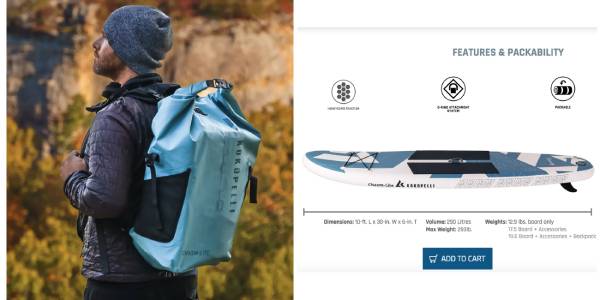Greetings, fellow adventurers!
Are you planning to set sail on your trusty kayak anytime soon?
Well, you might want to stick around for a bit, because we’re about to tackle a question that’s been bugging paddlers for ages: can your kayak sink?
Now, we know what you’re thinking. “Of course not! Kayaks are unsinkable!” But before you get too confident, let’s dive deeper (pun intended) into the issue and explore some hilarious tales of kayaking mishaps.
So, whether you’re a seasoned kayaker or a newbie, come join us on this buoyant journey and let’s find out together if your kayak can really sink. Trust us, you won’t want to miss this one!
Can Your Kayak Sink? What You Need to Know
Yes, kayaks can sink. Will your kayak sink, though? It is unlikely that kayaks would sink as they are designed to remain floating due to their buoyancy and other features.
What’s Preventing Your Kayak From Sinking?
Kayaks are designed to be buoyant. Kayaks often contain bulkheads, which are water and airtight sections which hold in the air and cause the kayak to float higher.
A lot of dividers in kayaks are constructed out of foam and if you don’t already have them, you can easily fit and install them yourself. Certain models of kayaks, including sit-on-top kayaks, have elements that keep them from sinking.
Sit-on-top kayaks feature scupper holes that permit water to be eliminated from the boat, thus avoiding the collection of any liquid inside the craft.
Your kayak would require a lot of force in order to be pulled downwards and exceed the buoyancy of it in order for it to sink.
Generally, an overloaded kayak, due to heavier cargo or an accumulation of water within itself, can result in stability issues.
The Risk of Sinking – It Depends on Your Kayak Type
Certain kayaks are more likely to sink than the rest. The Sit-On-Top kayak is usually the safest option when it comes to avoiding sinking.
Because of the construction of the sit-on-top kayak, water won’t gather in any meaningful quantity.
There is no cockpit that can fill with water. Furthermore, sit-on-top kayaks typically have scupper holes.
Holes are built into the kayak that permit water to escape in case it should ever enter the vessel.
The openings are generally sealed with stops, but you can open them when you have to discharge liquid.
Sit-on-top kayaks are designed with scupper holes to allow water to flow away, as it is prone to splash onto them more easily. On the other hand, sit-in kayaks do not usually feature scupper holes.
It’s difficult for inflatable kayaks to go under as long as there are no rips or punctures and the air chambers are in tact, working to keep it above water.
The ideal inflatable kayaks should have a minimum of three air compartments. Some have four. The more air chambers, the better.
A single air chamber in an inflatable kayak would raise the danger of it sinking; a single hole in the chamber would make the vessel unsalvageable and it would go to the bottom.
It would be difficult for anyone to locate an inflatable kayak that only contains one air compartment.
You should purchase an inflatable piece watercraft that has at least three or four air compartments. That way, if one compartment is punctured, the other ones will hold up, so keeping you afloat.
The risk of sinking is slightly higher for those who use a sit-in kayak than a sit-on-top kayak, although the danger is still not considered to be high. Alright, let’s look at the things which might make your kayak go underwater.
Things That Can Increase the Risk of Your Kayak Sinking
So, what things can cause your kayak to sink? Beware of potential dangers that can cause kayaks to capsize.
Too Much Load
It is incredibly risky to put too much weight in your kayak while on the water.
It’s critical that you abide by the weight limit specified in the manual provided with the kayak, as they can differ between models.
When you shop for a kayak on the web, the weight limit for it is usually presented on the page with the product information. Do not exceed the weight restriction of 300 pounds on your kayak.
It is generally advisable to be conservative and not go beyond the limit. If the maximum weight capacity is 400 pounds, it would be wise not to exceed 300 pounds with the load.
Both people and cargo count towards that load. Let’s revisit our illustration of a kayak with a maximum bearing capacity of 300 lbs.
If two people weighing a total of 150 pounds get on the kayak, there will be no more space for things like tents and fishing gear.
If the weight capacity is 400 pounds, it will give you extra room to bring along camping supplies, safety supplies, a pet, and other items weighing up to 100 lbs.
Low-Quality Materials
A kayak may sink if it is constructed from low-grade materials that are susceptible to damage.
For example, a low-quality inflatable kayak would be at increased risk of sinking, as it could get torn or punctured with ease.
It is important to put money into a kayak of superior quality that is created from tough PVC (if you’re considering an inflatable kayak), fiberglass, rotomolded plastic, etc.
Research reviews to guarantee the kayak is robust and resilient – it’s not worthwhile to buy an inexpensive kayak if that means compromising your own security.
Poor Storage and Maintenance
It is necessary to take good care of your kayak and keep it in good condition. Depending on the kind of kayak, it could endure harm from extreme cold, heat, and too much sunshine.
For instance, a kayak made from polyethylene can become misshapen and become weakened by the sun’s ultraviolet rays. It is very important to have a roof that blocks out UV rays to keep your kayak safe from sunlight.
Put your kayak inside rather than leaving it out, so if you don’t have a specific shed then your garage would be a suitable place.
Very low temperatures could also ruin your kayak, so it’s best to keep it away from the elements during the colder months, even if it’s usually stored outdoors.
Preserving and keeping your kayak in good condition will make sure the structure stays solid and won’t get ruptured or broken.
As time passes, your kayak may develop small cracks and holes in its hull without you initially realizing it.
Your kayak can become filled with water due to their presence while you are kayaking. If you observe water collecting in your kayak’s hull or cockpit while paddling, you should cease activity and exit the water immediately as it’s an admonition not to be taken lightly.
Examine your kayak and fix it or purchase a fresh one if needed.
There is a potential for the valves on an inflatable kayak to become loose or harmed, causing air to leak out. In situations like this, your kayak is able to go underwater even if it has not been punctured.
If the folding lines of a foldable kayak become broken or damaged, it can allow water to enter. Generally, with aged foldable kayaks, they have the potential to endure over 20,000 foldings before wearing out.
Understanding the Numbers: What Is a Kayak’s Weight Limit?
The weight capacity of a kayak has likely been included in the technical information which accompanies the boat. It is also possible that you did not really notice this or failed to comprehend its meaning, which would be a grave blunder.
What is the meaning of maximum weight limit, load limit, maximum capacity, and weight rating?
The highest possible weight a kayak can take before sinking is given by the producer and labeled on the product.
That’s the simplest way to put it.
The intention is to facilitate the selection of an appropriate kayak. Despite what was assumed, the maximum capacity labels have made things complicated for canoeists and novice adventurers.
No one in the kayak industry has established rules concerning how the maximum weight the kayak can hold has been decided. Each kayak producer operates according to its own regulations.
Some of them take a less risk-averse approach, while others err on the side of caution. Therefore, the specified load limit amount for various kayaks can differ vastly – even if the boats are the same size and created for the same objective.
What Factors Influence A Kayak’s Weight Limit
The positive aspect is that even though there is no one set way of calculating how much a kayak can take in terms of weight, there are still certain elements that can affect this figure regardless of what process the maker employed.
The following three factors influence how much a kayak can hold:
- Length of the hull
- Width or beam of the kayak
- Water displacement volume, as determined by the shape of the hull
The capacity of a kayak is computed utilizing its length, width, and depth (thickness).
And volume dictates the weight capacity of a kayak.
What Happens if you Exceed the Weight Limit on a Kayak?
It is not possible to be too lightweight for a kayak; however, there can definitely be too much weight for you and all your gear. And when that happens, trust me; you’ll know.
Can you put as much weight in your kayak as it can hold?
You have no reason stopping you from attempting it – theoretically speaking.
You will not instantly sink your kayak when it enters the water although it may have exceeded the weight capacity.
If you put more weight into a kayak than it is designed to carry, it will cause the boat to be unstable.
- Become noticeably harder to paddle
- Track poorly, feel sluggish and unresponsive.
- Take on more water as it sits closer to the water line
- Be in danger of capsizing, especially in rough waters
In conclusion, paddling on those waters is far from comfortable or safe.
Why does this happen?
Essentially, if your gear and yourself together exceed the weight capacity of your kayak, even slightly, it will cause the boat to ride lower in the water. This leads to greater air resistance, a decrease in stability, and a higher probability of taking in water, making kayaking much more dangerous and challenging than it should be.
How Much Weight Does the Average Kayak Hold?
Kayaks are constructed in various ways and intended for distinct objectives, and the weight capacity of each model consequently varies.
The important thing to take away is that everything should be varied.
Weight Capacity Limit of Recreational Kayaks
Kayaks made for recreational activities are great for leisure pursuits on still rivers and lakes, in balmy temperatures, over short trips and for nothing more than having fun and resting. It would be unwise to use a kayak for paddling through fast-flowing rapids or choppy oceans.
Well, at least I hope you wouldn’t.
In other words, because these items are meant to be used for fun, they shouldn’t be loaded down with excess weight. They have the lightest maximum capacity of all kinds of kayaks.
Apart from the necessaries for boating, it is unlikely that you would need anything else. The weight capacity should be able to support up to a maximum of 250 to 300 pounds, which is a bit limited.
Weight Capacity Limit of Touring Kayaks
Kayaks that are made for journeys that require a greater level of paddling such as long-term excursions and treks over several days typically occur in open water areas. It’s the exact opposite of a recreational ‘yak.
What activities do you participate in when you go on a multi-day kayaking trip?
You should include a variety of items, not just your normal kayaking gear, such as cookware, tents, sleeping bags, and other camping supplies.
Kayaks used for touring usually have a lot of storage areas and can hold up to 350 pounds of weight.
Weight Capacity Limit of Sit-On-Top Kayaks
Sometimes humorously referred to as a “lazy man’s boat,” sit-on-top kayaks are a popular option for paddlers. These boats are broader, more steady, simpler to step into and out of, and they have features that allow water to drain from them and keep them from being weighed down.
Generally speaking, sit-on-top kayaks are an excellent option for youthful paddlers and those just starting out.
Besides the lack of an enclosed cockpit, another thing that sets them apart from their sit-inside counterparts is weight capacity:
Sit-on-top kayaks usually can carry up to 350-400 pounds, which is approximately one hundred pounds more than the 300-pound capacity set for models with closed cockpits.
Weight Capacity Limit of Inflatable Kayaks
Despite their appearance, these so-called “glorified pool toys” – which some kayakers refer to in an endearing way – can accommodate more load than traditional hard-shell kayaks.
Think about it:
Inflatables have the qualities of being lightweight, wide, and full of air, which is basically the same as being buoyant.
Hence, do not be astounded to learn that of all the options, inflatable kayaks boast the most generous weight limit. Most inflatables are capable of supporting a weight of up to 400 lbs, while some “advanced” designs can accommodate as much as 900 lbs – making them an excellent choice for a heavier kayak.
Summary Of Average Weight Limit By Type Of Kayak
The maximum weight that a kayak can carry varies based on the design and intended purpose, as seen in the table below:
| Type Of Kayak | Average Weight Capacity |
|---|---|
| Recreational Kayak | 250 – 300 pounds |
| Fishing Kayak | 400 – 500 pounds |
| Touring Kayak | 300 – 400 pounds |
| Tandem Kayak | 500 – 600 pounds |
| Pedal Kayak | 400 – 450 pounds |
| Kids Kayak | 100 – 150 pounds |
| Whitewater Kayak | 200 – 250 pounds |
| Inflatable Kayak | 300 – 500 pounds |
| Foldable Kayak | 200 – 300 pounds |
| Sea Kayak | 300 – 350 pounds |
In Conclusion
Well, folks, we hope we’ve put your minds at ease (or maybe not!) about the possibility of your kayak sinking. Whether you’re planning a leisurely paddle or an adrenaline-pumping whitewater adventure, it’s always good to know the limits of your gear.
Remember, kayaking can be a ton of fun, but safety should always come first. Make sure to wear the proper gear, stay aware of your surroundings, and never underestimate the power of Mother Nature.
And if you ever do find yourself up the creek without a paddle (or a kayak, for that matter), just remember to keep your sense of humor intact. After all, the best stories always come from the craziest adventures.
Thanks for joining us on this wild ride. Happy paddling!




